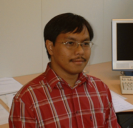Optical Waves in Inhomogenous Kerr Media Beyond Paraxial Approximation
19 September 2003
| Nowadays, a lot of research is devoted to realize all-optical telecommunication/information systems. To design all-optical devices, it is very important to understand the physical phenomena appearing in the structure. This thesis involves mathematical (analytical/numerical) modelling of the light propagation in a non-uniform Kerr medium. A Kerr medium is a medium where the light intensity induces the refractive index to change. It is one of the nonlinear materials. An example of it is an optical fibre. |
What is your thesis about?
Nowadays, a lot of research is devoted to realize all-optical telecommunication/information systems. To design all-optical devices, it is very important to understand the physical phenomena appearing in the structure. This thesis involves mathematical (analytical/numerical) modelling of the light propagation in a non-uniform Kerr medium. A Kerr medium is a medium where the light intensity induces the refractive index to change. It is one of the nonlinear materials. An example of it is an optical fibre.
In this thesis the validity of the paraxial approximation (the assumption that the light mainly travels in one direction) is studied with a focus on three physical phenomena: the optical bistability in one-dimensional nonlinear grating structures, the deformation of a bichromatic pulse (or equivalently two-plane waves in spatial domain), and the soliton propagation in a Kerr medium under the presence of transverse linear refractive index variation, including the break up of bound-N-solitons into N individual solitons. A soliton is a self-guide wave that propagates without changing its shape due to the dynamic balancing of diffraction and self-focusing effect.
(An N number of solitons travelling together with the same speed is called a bound-N-soliton.)
What did you find?
In the case of optical bistability, we found that the paraxial approximation (nonlinear transfer matrix method) is valid only for the case of weak nonlinearity such as in a defect structure. The remarkable result of this thesis is that the nonparaxiality is a very sensitive parameter in the bi-plane wave deformation as well as in the break up of bound soliton.
Is there a practical application for this?
This is a theoretical study entirely. A lot of research still has to be done for practical application. The challenging application in future is for all-optical data transmission/processing such as logic gate, switching, optical memory, etc. The main obstruction is that the existing materials at this moment, generally, only have a very small nonlinearity. However, a large number of researches have been directed to develop materials with larger nonlinear effects.
How come a mathematician got interested in optical fibre?
At the beginning of my PhD study I did not know anything about optics, but I was involved in a research project on water waves propagation, which are waves after all. The mathematical models behind it are very comparable. I was lucky and was asked to join this project.
Did you work in a group?
Yes, I worked in the group of applied analysis and mathematical physics. This group also has close contact with the Lightwaves Devices Group, which is now called Integrated Optical MicroSystems from Electrical Engineering. Every week we have had meetings about what’s happening in the research.
You did your Master’s here as well, so for how long have you been in the Netherlands?
Six years, but a week after my promotion I shall return to Indonesia. I am still formally employed by the Brawijaya University in Malang and will teach there and do research.
The conditions for research will have to be improved and that will be one of my jobs when I return. I find that very challenging.
How do you look back on those six years?
In the beginning of my study here I had to get used to being away from my family. Before I came here I had never travelled much. It took some time to adapt to the different culture and there were language problems as well, I hardly spoke English. But I picked that up soon enough. In 2001 my wife came over, which made life easier. Also the fact that there were two conferences in Indonesia and that I could go back once a year was very good. I also went to other conferences in England, Germany and to Prague the Czech Republic. The possibility of attending so many conferences is one of the advantages of doing a PhD here, as well as the close contacts in the group, the contacts with my professors and the facilities offered. It is all very stimulating.
The disappointing thing was that getting my wife over here was so extremely difficult and that it was virtually impossible to get a place in day care for my daughter. My wife wanted to do a PhD as well, but when our baby arrived we had to choose who was to continue due to that fact. We decided that I was the one.”
For the summary of the thesis, click here. (English)

